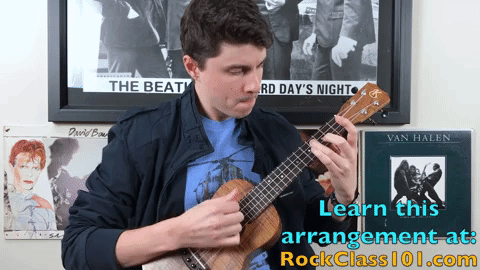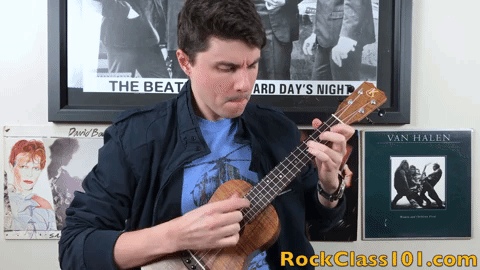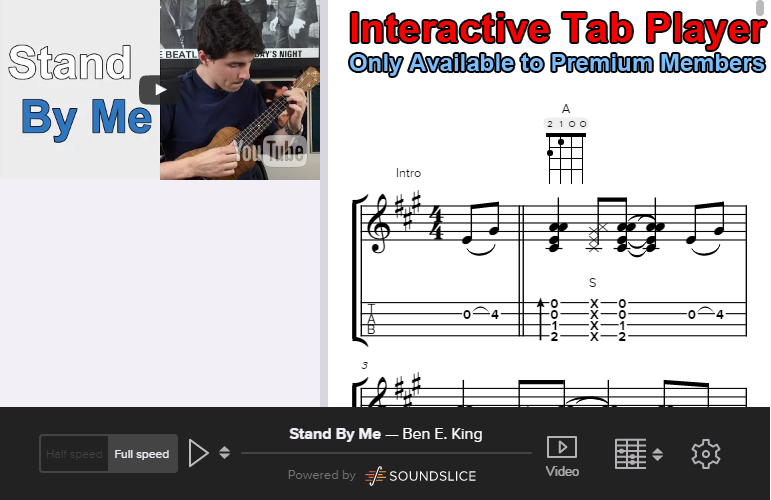Understanding and Applying Vibrato on Ukulele
Vibrato is a technique that tends to have a bit of mystery surrounding it. To fully understand it, let's take a step back and see how it fits into the 4 distinct qualities that define every musical note. As an ukulele player, we have complete control over these 4 characteristics. In other words, we can create a unique emotional expression of the music that we play, by simply deciding how to handle each of these qualities.
The 4 qualities are:
1) Pitch
2) Duration
3) Volume
4) Tone
A pitch is a particular frequency of sound, for example 440 Hz. While, a note is a named pitch. For example, Western music generally refers to the 440 Hz pitch as A, specifically A4. This is the A above middle C.
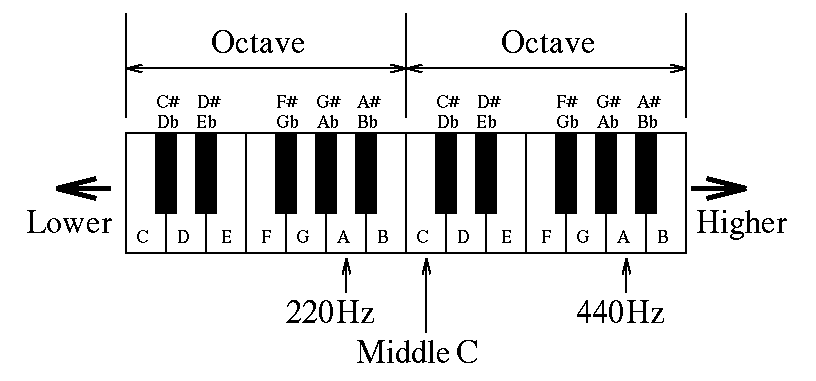
The primary means of achieving variation in the pitch is with vibrato. This is achieved with two variables: speed and width. For example, a slow and wide vibrato is more lyrical, on the contrast, a fast and short vibrato is more intense. These 2 variables can be interchanged, but generally you'll want to match the pulse of the vibrato to the feel of the music. This helps to create a constant, harmonic effect.
Vibrato Example #1: Subtle Effect
Let's take a look at an example of how 2 variations of vibrato can be used in the same piece of music. Our reference piece will be "We Three Kings".
This arrangement begins with the melody being played simplistically and slowly. Therefore, our first example of vibrato will attempt to match this feel. Take a look at the video below to hear how a slow [speed], slight [width] vibrato adds a subtle effect to the Em and G chords.
Here are the chords depicted in the video/GIF below which use vibrato:
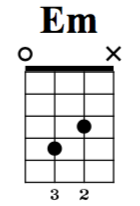
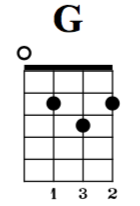
I've included a GIF of this phrase to further show the application of a subtle vibrato. Notice how a slight vibrato requires a small amount of movement.
Vibrato Example #2: Pronounced Effect
On the contrary, our second example uses a fast [speed], wide [width] vibrato on the Em chord to create a pronounced effect. This in turn mimics the performance. While we are playing the same melody, we have to take into account that our tempo has boosted and that our harmony has become more complex. With this in mind, listen to how the pulse of the vibrato matches the feel of the music.
I'd encourage you to click on the "cog" in the video player and toggle the speed to 50%. This will help you hear and see the application of the vibrato. Again, I've included a GIF of this phrase below to further show the application of a pronounced vibrato. Notice how a wide vibrato requires a large amount of movement.
How to Apply Vibrato to Notes and Chords
Tab Play Along for 5 Vibrato Exercises
The mechanics behind applying vibrato differs between notes and chords; specifically, barre chords. If we are playing a fretted single note(s) or a chord played with the fingertips (non-barred), such as the G chord used in the example above, we will be applying an up-and-down movement to create vibrato.
On the contrast, when barring a chord, we will be applying a sideways (left to right) movement to create vibrato. This also applies to partial barre chords, or barred interval such as:
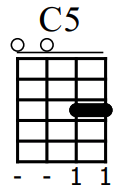
Although the movement to create vibrato differs between notes and chords, a couple basic principles apply to each application. First off, you want to make sure to apply enough pressure to create a clear sounding note/chord. It's imperative to only push hard enough so that the note/chord rings true. If we push too hard, the note/chord will go sharp. If we push too lightly, the note/chord will not ring out and/or contain fret buzz.
Next, you want to keep pressure applied throughout the duration of the vibrato. In other words, keep the note/chord held down as if you were playing it as normal. While holding the note/chord down, you will apply the movement to create vibrato. Which now brings us full circle to the beginning of this lesson: You must decide what type of vibrato to create by adjusting the two variables: speed and width.
Below, we will take a look at 5 examples of vibrato. Each example utilizes a different speed and width to create a vibrato that matches the pulse and feel of the musical phrase.
Ex. 1: Single Notes - "Twinkle, Twinkle, Little Star"
In our first example, we will be applying a slow [speed], slight [width] vibrato to create a subtle and sweet sounding tone. Remember that our movement for this type of vibrato is up and down.
For extra practice, check out our fingerstyle arrangements of "Twinkle, Twinkle, Little Star". This arrangement uses chords to create the melody as opposed to single notes. The same vibrato approach and execution can be used for the fingerstyle arrangement.
* Note: The lesson for exercise 1 begins at 14:21 in the YouTube video above.
Tablature for Example 1
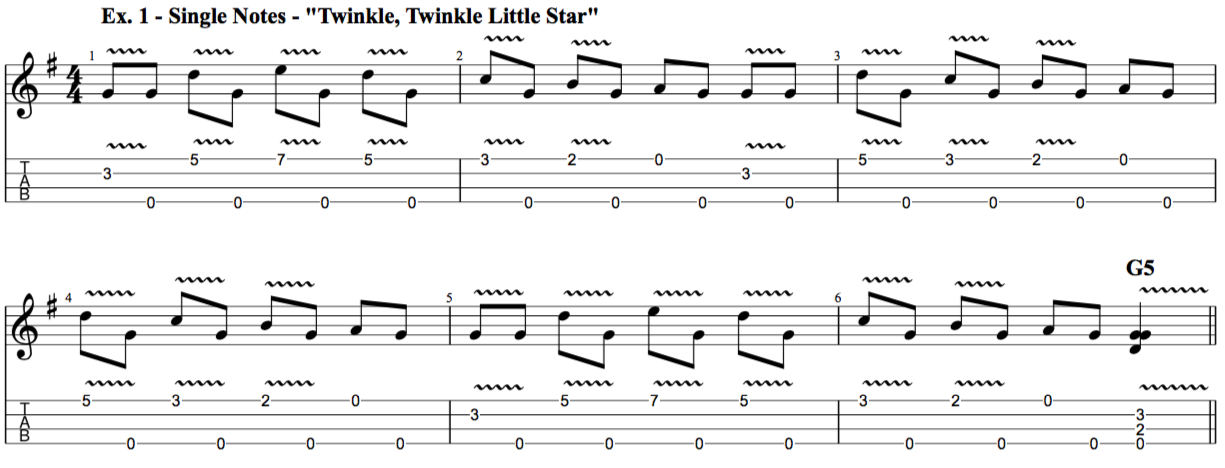
Ex. 2: Single Notes - "Waiting on the World to Change"
In this example, we'll be looking at the ending phrase of John Mayer's solo in "Waiting on the World to Change". We will be applying a fast [speed], wide [width] vibrato to create a pronounced and intense dynamic.
Remember that our movement for this type of vibrato is up and down; but, notice the difference in movement required to create an exaggerated sound as opposed to example 1.
* Note: The lesson for exercise 2 begins at 21:52 in the YouTube video above.
Tablature for Example 2

Ex. 3: Intervals - 2 Chord Jam: EP004
In our third example, we'll be looking at the first phrase that was played in Concept Lesson EP004. Just as in example 1, we will be applying a slow [speed], slight [width] vibrato to create a subtle and sweet sounding tone. But this time around, the vibrato will be applied to intervals (2 notes). Remember that our movement for this type of vibrato is up and down.
* Note: The lesson for exercise 3 begins at 30:15 in the YouTube video above.
Tablature for Example 3

Ex. 4: Barre Chords
In example 4, we will be applying a fast [speed], moderate [width] vibrato to create an amplified, yet sweet sounding tone. This phrase is a great example of how you can mix and match speed and width to create an interesting dynamic.
It's as if this vibrato is a hybrid between lyrical and intense. Listen to how it fits perfectly with the overall feel of the 16th note musical phrase. The vibrato holds its own against the quick barrage of notes, yet isn't over the top.
Remember that our movement for this type of vibrato is sideways (left to right).
* Note: The lesson for exercise 4 begins at 36:20 in the YouTube video above.
Tablature for Example 4
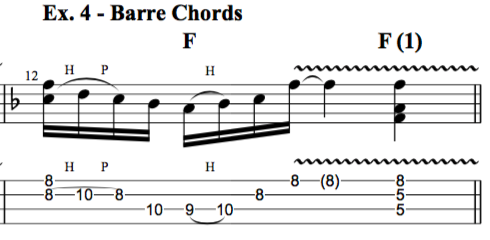
Ex. 5: Single Notes & Chords - "Red House"
In example of 5, we'll be looking at the beginning phrase of Jimi Hendrix's song, "Red House". Just as in example 2, we will be applying a fast [speed], wide [width] vibrato to create a pronounced and intense dynamic. Remember that our movement for this type of vibrato is up and down; but, will be sideways (left to right) for the barre chord at the end of the phrase.
* Note: The lesson for exercise 5 begins at 42:47 in the YouTube video above.
Tablature for Example 5
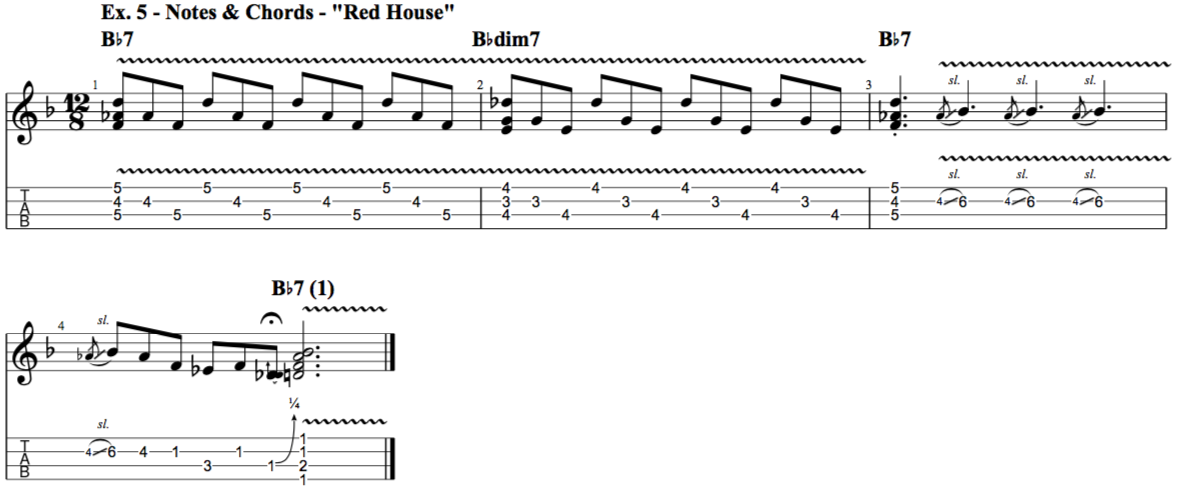
Suggestions for Continued Practice
Upon completion of this lesson, you should have a good grasp on not only how to do vibrato, but also how to apply it to match the correct feel of a piece. I'd highly encourage you to revisit pieces that you already know and consider how the addition of vibrato could enhance the expression of a passage.
Furthermore, listen to some of your favorite ukulele players and listen to how they elegantly implant vibrato into their playing. This will help to reinforce and train your ear to recognize proper application of vibrato in varying styles of music.
"But, what about the other 3 qualities of the musical note?"
Yes, this is a great question. In this lesson, we only touched upon the first quality: pitch. This is due to the fact that vibrato goes hand-in-hand with pitch. In a future lesson, we will cover the other 3 qualities in detail. But for now, I will leave you with a short summary of the 3 remaining qualities:
1) Duration - Deals with rhythm and timing of the note. For example, a note can be played with staccato (short, detached) or legato (long, connected).
2) Volume - There are two types of dynamic contrast in music; but for now, think of it simply as the dynamic of playing soft or loud.
3) Tone - The ukulele benefits in the fact that there is a rich variety of tonal colors (timbres) available. Depending on left and right hand factors (for example, picking over the sound hole versus near the bridge), we can create a wide tonal landscape ranging from bright and piercing, to sweet and lush.
Article by: Andrew Hardel

